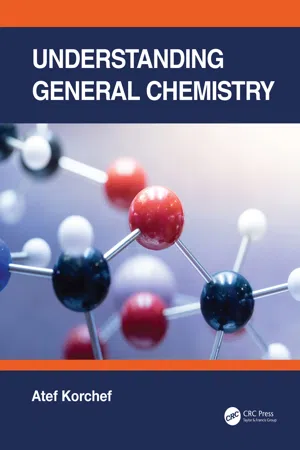Chemistry
Prediction of Element Properties Based on Periodic Trends
The prediction of element properties based on periodic trends involves using the periodic table to anticipate the behavior and characteristics of elements. This is done by recognizing patterns in the periodic table, such as atomic size, ionization energy, and electronegativity, which can help predict how elements will interact with other substances and their physical and chemical properties.
Written by Perlego with AI-assistance
Related key terms
Related key terms
1 of 4
Related key terms
1 of 3
10 Key excerpts on "Prediction of Element Properties Based on Periodic Trends"
- eBook - ePub
Foundations for Teaching Chemistry
Chemical Knowledge for Teaching
- Keith S. Taber(Author)
- 2019(Publication Date)
- Routledge(Publisher)
Two other concepts, however, can be linked more directly to a model of atomic structure – at least for the first 20 elements. The periodic table is arranged into rows known as periods and columns known as groups. That geometric notion links to atomic structure (so an element in period 2 has atoms with two occupied shells of electrons; an atom of an element in group 3 has three electrons in its outer shell – and so the element in period 2 and group 3, B, has an electronic configuration of 2.3). This also relates to periodicity. Elements in the same group are said to share common properties, whilst there are often clear trends in properties moving across periods.Common group properties
Those common group properties and periodic trends reflect certain patterns abstracted from a vast catalogue of data. The patterns of stoichiometry, such as for the period 2 chlorides shown earlier, is strong but has limits. In period 3 some elements, even in the p-block, show more than one valency (e.g., PCl3 and PCl5 ; IF, IF3 , IF5 , and IF7; etc.) – due to the ‘expansion of the octet’, a complication that cannot be readily explained with the simple ‘shells’ models of electronic structure. This links to a common alternative conception that students acquire – that electron shells (not just the L shell) become ‘full’ at eight electrons. Unfortunately, this is something implied (or even stated) in some school textbooks (Taber, 1998a).Elements in the d-block commonly show multiple valencies, but the actual patterns of valencies found are more difficult to explain. The alkali metals are all relatively soft, low-melting, highly reactive metals; the halogens are coloured non-metals; but then nitrogen, arsenic, and bismuth do not so obviously have much in common. This is not to suggest that chemists are unable to explain patterns using the periodic table, but rather that whilst some patterns can be readily related to the periodic table using a simple ‘shells’ model of atomic structure of the kind commonly met in introductory chemistry, other patterns need to be related to more sophisticated structural models or interpreted in terms of complex patterns of factors (see the example of ionisation energy in Chapter 12 ).Trends in the periodic table
The periodic table subsumes the important chemical concept of trends in elemental properties. The trends concept is used more widely – for example in economics – so students may be familiar with it from outside the chemistry classroom. News reports may refer to trends in unemployment or in industrial production or in professional sportspeople’s earnings. In everyday usage, a trend refers to a pattern of change over time , and periodic or group patterns are only trends by analogy, in the sense that we conventionally read a periodic table according to an assumed ordering (see Figure 9.1 - eBook - ePub
- Jeffrey Gaffney, Nancy Marley(Authors)
- 2017(Publication Date)
- Elsevier(Publisher)
As described by the Periodic Law, there are trends in many properties of the elements in the periodic table which increase or decrease systematically as you move across a period or down a group. These periodic trends can be explained by the changes in electronic configuration of the elements within the periods or groups. Some important periodic trends are: atomic radius, ionization energy, electron affinity, and electronegativity. These observed trends give chemists a useful tool that allows them to predict an element's properties, chemical reactivities, and types of compounds that it will form from their position in the periodic table.Perhaps the first periodic trend to be observed is that of changing atomic radius . The atomic radius is the distance from the nucleus to the outermost occupied electron orbital in an atom. As shown in Fig. 2.14 , the atomic radii follow a fairly regular pattern of a minimum followed immediately by a maximum and then decreasing steadily to the next minimum as atomic number is increased. The maximum radii are found for the alkali metals in group 1; lithium (atomic number 3), sodium (atomic number 11), potassium (atomic number 19), rubidium (atomic number 37), cesium (atomic number 55), and francium (atomic number 87). These maxima are followed by a steady decrease in atomic radius with increasing atomic number until reaching a minimum. The minimum radii are for the noble gases in group 18; helium (atomic number 2), neon (atomic number 10), argon (atomic number 18), krypton (atomic number 36), xenon (atomic number 54), and radon (atomic number 86). So, the atomic radius decreases from left to right across a period.Fig. 2.14 Atomic radius in picometers as a function of atomic number for elements 1–95.The reason for this decreasing trend in atomic radii occurs because as atomic number increases proceeding from left to right across a period, the electrons are added to the same electron shell. This has little effect on increasing the atomic radius. But, as the electrons are added to the shell, protons are also added to the nucleus. Increasing the number of positively charged protons in the nucleus causes the attraction between the valence electrons and the nucleus to become stronger, pulling the valence shell closer to the nucleus. So, the atomic radius decreases across a period as protons are added to the nucleus. - Ponnadurai Ramasami(Author)
- 2022(Publication Date)
- De Gruyter(Publisher)
Without Mendeleev’s discovery, the epistemic core of modern chemistry would be very different and concepts such as electronic configuration, oxidation and reduction, polarisation, intermolecular interactions, types of bonding, Lewis acid/base, etc. would disappear in our vernacular [ 3 ]. Understanding the periodicity of properties of elements, hence the related predictability of elemental properties, based on the similarities within a group and the variations along a period, is critical knowledge of the fundamental aspects of chemistry [ 4 ]. Nevertheless, chemistry educators find it difficult to teach and students encounter difficulties in learning the periodic table [ 5 ]. Students have several alternate conceptions about the periodic trends due to memorisation of facts and lack of conceptual understanding [ 6 ]. The teaching of the Periodic Table seems a tedious and boring task [ 7, 8 ], and many students often perceive the topic Periodic Table as difficult and confusing [ 9 ], depending on the approach the educator uses [ 10 ]. Rather than focussing on memorisation of facts and figures for each element, chemistry educators need to develop students’ understanding of the regular patterns in chemical and physical properties of the elements in the periodic table, thus encouraging them to “think like scientists” [ 4 ]. This would enable students to construct knowledge from their prior conclusions and alternate conceptions, rather than relying on rote memorisation. Chemistry educators’ pedagogical content knowledge is critical to enable an active engagement of all students and facilitate the learning process from existing knowledge and alternate conceptions associated with the periodic table- Christopher R. Hren, John T. Moore, Peter J. Mikulecky(Authors)
- 2022(Publication Date)
- For Dummies(Publisher)
periodic table of the elements! But don’t be fooled by its stern appearance or intimidated by its teeming details. The table is your friend, your guide, your key to making sense of chemistry. To begin to make friends with the table, concentrate on its trends. Start simply: Notice that the table has rows and columns. Keep your eye on the columns and rows, and soon you’ll be making sense of things like atomic radii and valence electrons. Really.Organizing the Periodic Table
In nature as well as in manmade systems, you may notice some repeating patterns. The seasons repeat their pattern of fall, winter, spring, and summer. The tides repeat their pattern of rising and falling. Tuesday follows Monday, December follows November, and so on. This pattern of repeating order is called periodicity.In the mid-1800s, Dmitri Mendeleev, a Russian chemist, noticed a repeating pattern of chemical properties in the elements that were known at the time. Mendeleev arranged the elements in order of increasing atomic mass (see Chapter 3 for a description of atomic mass) to form something that fairly closely resembles the modern periodic table. He was even able to predict the properties of some of then-unknown elements. Later, the elements were rearranged in order of increasing atomic number, the number of protons in the nucleus of the atom (again, see Chapter 3 ). Figure 5-1 shows the modern periodic table.FIGURE 5-1: The periodic table of the elements.Examining the organization of the periodic table
Chemists can’t imagine doing much of anything without having access to the periodic table. Instead of mastering the properties of 118+ elements (more are created almost every year), chemists — and chemistry students — can simply get a firm grasp of the properties of families of elements, thus saving a lot of time and effort. You can find the relationships among elements and figure out the formulas of many different compounds by referring to the periodic table. The table readily provides atomic numbers, mass numbers, and information about the number of valence electrons (the outermost s and p electrons; see Chapter 6- eBook - ePub
- Léna Soler, Sjoerd Zwart, Michael Lynch, Vincent Israel-Jost, Léna Soler, Sjoerd Zwart, Michael Lynch, Vincent Israel-Jost(Authors)
- 2014(Publication Date)
- Routledge(Publisher)
The simultaneous presentation of many such relations facilitates the recognition of higher-order patterns. Categories such as “halide” and “transition metal” emerge and trends in electronegativity, ionization energy, and oxidation states can be rationalized, in part because they become readily identifiable. Patterns of atomic volumes and ionic radii become conspicuous and consequently make a multitude of facts concerning chemical bonding and reactivity comprehensible and predictable (see Figure 4.5). Figure 4.5 Trends for some chemical and physical properties of the elements as organized by the modern periodic table The periodic table’s ability to guide reasoning, and inquiry more generally, flows from this particular way of aggressively projecting order onto its complicated domain. The nature of this guidance is suggestive, however, rather than explicitly inferential. The periodic table displays patterns and implicitly represents them to be far-reaching and robust. The prediction of a new element, for instance, follows from recognition that something is absent from the imposed structure. The table reveals a “hole” and insinuates that something is missing. But there is no formal structure to generate quantitatively precise predictions. It is also significant that much of the reasoning supported by the periodic table is analogical. A category such as “halide” is important within the practice precisely because it allows us to reason, “If compound X displays certain properties, then the related compound Y will display analogous properties”. In a domain such as descriptive chemistry, analogical reasoning is an important tool for gaining control over complexity; a multitude of facts can be managed if they fall into conspicuous patterns rather than remain independent and singular. As I have argued, a tabular format, in particular, carves out such patterns - Albert S. Tarendash(Author)
- 2021(Publication Date)
- Barrons Educational Services(Publisher)
Pages 256–258 )9.6Concept: For Groups 1, 2, and 13–18 in the Periodic Table, elements within the same group have the same number of valence electrons (helium is an exception) and, therefore, have similar chemical properties. (Page 244 )Skill: Given the chemical formula of a compound (such as XCl or XCl2 ), determine the group of an element (X). (Pages 256–258 )9.7Concept: The succession of elements within the same group demonstrates characteristic trends: differences in atomic radius, ionic radius, electronegativity, first ionization energy, and metallic (or nonmetallic) properties. (Pages 248–255 )Skill: Compare and contrast the properties of elements within a single group (Groups 1, 2, 13–18) in the Periodic Table. (Pages 248–255 )9.8Concept: The succession of elements across the same period demonstrates characteristic trends: differences in atomic radius, ionic radius, electronegativity, first ionization energy, and metallic (or nonmetallic) properties. (Pages 248–255 )Skill: Compare and contrast the properties of elements across a period (for Groups 1, 2, 13–18) in the Periodic Table. (Pages 249–258 )9.9Concept: When an atom gains one or more electrons, its radius increases. When an atom loses one or more electrons, its radius decreases. (Page 247 )Passage contains an image
9.1 INTRODUCTION
The first question we need to ask is this: Why do we have a Periodic Table of the Elements? The term periodic means that a quantity repeats itself at regular intervals. For example, the motion of the Moon around Earth is periodic because, after a certain length of time (1 month), the motion repeats itself. As early as the Middle Ages, scientists recognized that elements could be differentiated by their physical and chemical properties. These properties are also periodic—if we list the elements properly.- eBook - ePub
Introduction to Geochemistry
Principles and Applications
- Kula C. Misra(Author)
- 2012(Publication Date)
- Wiley-Blackwell(Publisher)
In 1869, two very similar arrangements of the known elements, much like the modern Periodic Table (Fig. 2.8), were published independently, one by the Russian chemist Dimitri Ivanovich Mendeleev (1834–1907) and the other by the German chemist Lothar Meyer (1830–1895). Both were based on regular periodic repetition of properties with increasing atomic weight of the elements, Mendeleev’s largely on chemical properties and Meyer’s on physical properties. The modern version of the Periodic Table is organized on the basis of atomic number of the elements, a concept that was developed some 50 years later than Mendeleev’s work and is more fundamental to the identity of each element. The vertical columns in the Periodic Table are referred to as groups, and the horizontal rows are referred to as periods, which are numbered in accordance with the first quantum number of the orbitals that are being filled with increasing atomic number. For example, electrons fill the 1 s orbital in elements belonging to the 1st period, 2 s and 2 p orbitals in elements of the 2nd period, and 3 s and 3 p orbitals in elements of the 3rd period. The electron distribution in elements included in the 4th to 7th periods becomes more complicated because of filling of d and f orbitals (3 d, 4 d, 5 d, 6 d, 4 f, 5 f) as illustrated in Fig. 2.8. Elements within a period have properties that change progressively with increasing atomic number because of addition of electrons. In contrast, elements in any group have similar physical and chemical properties because of similar electronic configuration. The groups are either designated as A and B, and numbered from left to right in accordance with the highest possible positive valence of the elements in that group (American system) or numbered continuously from left to right as 1 through 18 (International system) - R.A. Mackay(Author)
- 2017(Publication Date)
- CRC Press(Publisher)
Table. 2.14 that these increase towards the right of the Periods and decrease down the Groups. In addition, they reflect the other, smaller, variations which have been remarked; for example, the changes in the Main Groups are more pronounced than in the Transition Groups, and the discontinuity in properties of the elements from gallium to bromine when compared with the rest of their respective Groups is reflected in their electronegativity values.8.5 Chemical behaviour and periodic position
The detailed chemistry of the elements is discussed in the succeeding chapters. In this section, the skeleton of the periodic properties is outlined to provide a framework for the more detailed account which follows.Those elements where the outermost electrons are in a new quantum level, after a rare gas configuration, normally react by losing these loosely bound electrons and forming cations. This mode of behaviour is typical of the elements of the lithium, beryllium and scandium Groups together with the lanthanide elements, which have the respective valency shell configurations, s1 , s2 and d1 s2 . All these elements, with the exception of beryllium itself, lose these outer electrons completely with the formation of cations; M+ in the lithium Group, M2+ in the beryllium Group, and M3+ for scandium, yttrium and the lanthanides.The elements of the boron, carbon, nitrogen, oxygen, and fluorine Groups, where the outermost electrons are in p orbitals, show more complicated behaviour.(a) Elements with electron configurations close to the rare gases can acquire electrons to form anions with complete rare gas shells. Thus the elements of the halogen Group all form X– ions, and we also find stable compounds containing O2− , S2− and N3−- No longer available |Learn more
- Steven Boone, Drew H. Wolfe(Authors)
- 2011(Publication Date)
- Collins Reference(Publisher)
CHAPTER 9Periodic Properties of Elements and Atoms
N ineteenth-century scientists such as Julius Lothar Meyer (1830–1895) and Dmitri Mendeleev (1834–1907) recognized that if the elements were placed in order of atomic mass (they did not know about atomic numbers), various properties of atoms recurred at regular intervals. Both Meyer and Mendeleev proposed Periodic Tables that placed elements with similar properties in the same group. Today, we know that these recurring properties result from the fact that the elements in the same chemical group have the same valance electron configuration that only differs by energy level. In this chapter, the periodic properties of elements and atoms are considered.9.1 THE PERIODIC LAWThe Periodic Law states that the properties of the elements are periodic functions of their atomic number. In other words, if the elements are listed in order of their atomic numbers, regular patterns of chemical and physical properties are found.MetalsThe physical properties of metals vary widely, but most metals share a set of common properties. Most metals are solids at room temperature with the exception of mercury, which is a liquid. Metals are a silvery gray color and are lustrous when polished. However, bismuth is pink, copper is red, and gold is yellow. They usually have high melting and boiling points, have a high average density, and are excellent conductors of heat and electricity. They are malleable, which means they can be hammered into various shapes and foils. Metals are also ductile, which means they can be drawn into wires.NonmetalsIn many cases, nonmetals possess properties that are opposite to those of metals. Most nonmetals are liquid and gases, not solids. On average, the melting points, boiling points, densities, and electric and heat conductivities of nonmetals are lower than those of metals. Nonmetals are neither malleable nor ductile. - eBook - ePub
- Atef Korchef(Author)
- 2022(Publication Date)
- CRC Press(Publisher)
7 Periodic Table of Elements and Properties of Atoms
DOI: 10.1201/9781003257059-77.1 Objectives
At the end of the present chapter, the student will be able to:- Explain how elements are arranged in the periodic table of elements.
- Determine the position of an element in the periodic table.
- Recognize the different categories of elements in the periodic table of elements.
- Describe the properties of atoms and how these properties vary along a period or along a group in the periodic table of elements.
7.2 The Periodic Table of Elements
In the periodic table of elements, the elements are arranged in order of increasing atomic number (Z). The vertical columns of the table (numbered from 1 to 18) are called groups or families. Elements in the same group have similar but not identical characteristics.The horizontal rows of the table (numbered from 1 to 7) are called periods (Figure 7.1 ).FIGURE 7.1 The periodic table of elementsElements in the same group have the same number of valence electrons (same number of electrons in the outermost shell), and hence similar chemical properties. The valence electrons are the electrons that are transferred or shared when atoms bond together.- Examples:
- 1 H: 1s1
- 3 Li: [He] 2s1
- 11 Na: [Ne] 3s1
- 19 K: [Ar] 4s1
- 37 Rb: [Kr] 5s1
- 55 Cs: [Xe] 6s1
- 87 Fr: [Rn] 7s1
- Examples:
- 5 B: 1s2 2s2 2p1
- 6 C: 1s2 2s2 2p2
- 7 N: 1s2 2s2 2p3
- 8 O: 1s2 2s2 2p4
- 9 F: 1s2 2s2 2p5
- 10 Ne: 1s2 2s2 2p6
In the periodic table of elements, the elements can be arranged according to their electronic configuration. For example, the position of an element in the periodic table can be defined easily using its electronic configuration, and more specifically, using its valence shell and valence electrons. Indeed, the number of valence electrons indicates the group in which the element is situated, and the valence shell gives the period in which the element is situated (Figure 7.2
Index pages curate the most relevant extracts from our library of academic textbooks. They’ve been created using an in-house natural language model (NLM), each adding context and meaning to key research topics.
Explore more topic indexes
Explore more topic indexes
1 of 6
Explore more topic indexes
1 of 4









